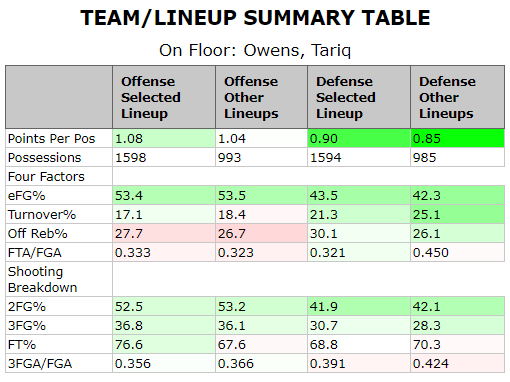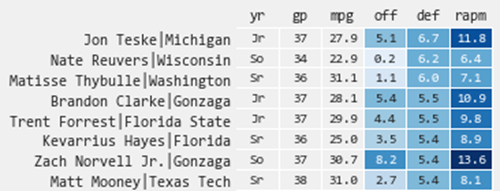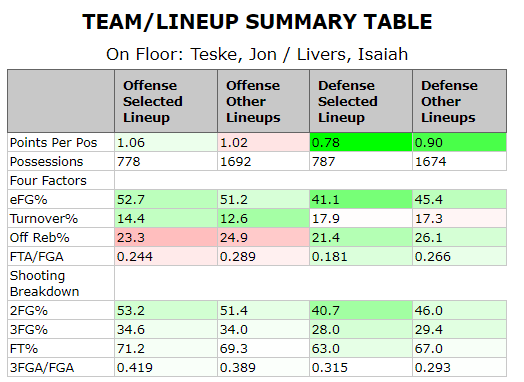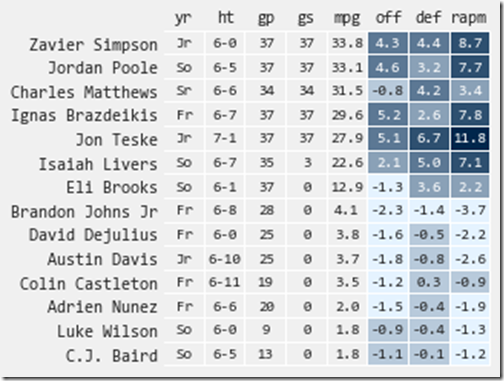
Let's Chisel Some Stuff Out Of A Weird Plus/Minus Stat

This hit the feed today and caused a spiral of google searching and squinting at dense technical stats articles:
Introducing Bayesian Adjusted RAPM for NCAA! Norvell/Hunter top the list in 2019 - see more @tothemean https://t.co/z15ybWpr7Z pic.twitter.com/WtslRbKqXz
— Jesse Fischer (@jessefischer33) May 1, 2019
Naturally, you are thinking "what the hell is that?" if you didn't immediately log off. If this stat (BARAPM) adds any more components it's going to sound like you're firing a machine gun whenever you mention it.
[AFTER THE JUMP: wonkery and then an Isaiah Livers takeaway]
After the squinting this is my take:
- It starts with plus/minus. That's the PM.
- It adjusts for who is on and off the court with you. That's the A.
- These results are then "regularized," which is a mumble something regression uh… ok. It's a mathematical technique that's supposed to reduce the problems induced by substitution patterns* and make the overall data less noisy. This is the R.
- The BA takes the regression in the previous bullet and changes the target from a league average player to a combination of tempo-free stats and overall team quality.
*[ie, if two bench guys share most of their minutes it's tough to determine which of them is causing the difference between their play and that of other lineups]
After going through all that and looking at BARAPM stats on O and D for several years I have the following conclusion: it's still a plus-minus stat that is dependent on your teammates. The regression does throw players on good teams up high, but that's kind of defining good as good.
For instance: Texas Tech lands five guys in the top 50 of D-BARAPM this year. None of them are named Tariq Owens. They're Matt Mooney, Davide Moretti, Jarrett Culver, bench wing Brandone Francis, and Owens's backup Norense Odiase. This makes some sense since Texas Tech's defense is actually a bit worse with Owens on the court:
But a big part of that is Odiase, the 6'9" 250-pound senior who split minutes with Owens at the 5. If Owens, the starting C on the best D in the country, was backed up by a numpty he'd rocket up the list as the team got worse.
The best examples of this in the top 50 who are familiar to Big Ten fans are Kaleb Wesson and Isaac Copeland. Neither is a standout defender. Wesson has a block rate of 2.9% as a ground-bound center; Copeland was an all right switchable four. They're on this list because of what happens when they go out: for much of the year Wesson got replaced by his 6'6" brother, and when Copeland got hurt Nebraska put in Tanner Borchardt and lost their switch-everything ability.
So I think this stat is potentially useful, especially on defense where stats are hard to come by, but it can't be used as a straight up ranking of players. Team context is too important in any plus/minus stat, and this is still one. That said:
SOME MICHIGAN STUFF
Your #1 most dude in D-BARAPM last year:
Teske was also 9th last year. Context here is important, obviously. Last year Teske was backing up Moe Wagner. This year he was backed up by a rotating cast of short guys, guys who can't jump, and skinny guys. We want Teske to fall back down the list because Colin Castleton becomes an excellent sidekick.
There are two more Michigan players in the top 50, but you'll need three guesses to get them. X: yes. Matthews: no. Livers: yes.
This is impressive, and very good news as Michigan seeks to keep their defensive efficiency up. Almost a third of Livers's possessions came as a small-ball center, where he was worse than the other options. (On average.)
For Livers to make the machine gun stat list of top defenders he had to annihilate it on the other two thirds of his possessions. The vast majority of these (all but ~100) came next to Jon Teske, and yup:
Livers is enough of an upgrade on Iggy defensively to expect he'll be able to more or less replace Matthews. In fact, lineups with Teske/Iggy and one of Matthews/Livers gave up an identical 0.84 PPP. Matthews is a better defender, in all likelihood. Livers is on this list because the guy he replaced was a meh defender. Matthews is not because the guy who replaced him much of the time was Livers. But there's every reason to expect Michigan will have three elite defenders in the starting lineup again next year.
Unfortunately only 10-15 of those minutes will be new Livers minutes; Michigan will have to find a bench player to step up if they're going to maintain their level from last year.
TEAM CONTEXT
Michigan's six-man-rotation and cliff is easily observable in the team data:
A few points of interest:
- Charles Matthews might not be that hard to replace given the Livers items above and his overall negative impact on Michigan's offense.
- Eli Brooks will be a solid bench player if he can shoot all right.
- Castleton scraping above zero on defense despite playing as Teske's backup is impressive. Limited time, obviously, but early returns are encouraging. He should be a plus defender.
This has been "can we make this stat weirder." Thank you for getting to the end.
I made it! And I think I understand everything what was discussed!

So this is Bayesian Adjusted Regression Adjusted Plus Minus? Or Bayesian Adjusted Regularized Adjusted Plus Minus?
Why not just take counting stats and divide by 40 because that's how many minutes are in a game?
BOOM WILBON'D
BABARAPM = Brian-adjusted Bayesian Adjusted Regularized Adjusted Plus Minus
Come, they told meeee...
BABARAPM
A newborn king to seeee....
BABARAPM
See I went right to the sound Adam West's Batman's fist makes when it connects with a Proton Deinhibiting Protenzer
woooooooooooooah black betty
Barapm
Wooooooooooooah black better
Barapm
How much, if any, of each players rating is impacted by offense?
Exactly 50% of the metric is based on offense and 50% is based on defense. The players impact on team performance on each end of the floor is isolated as the offensive metric and defensive metric and then the total rapm is literally the sum of the off and def stats.
The metric is very easily explained (getting there not so much). Your def number is approximately how much better your team performs on defense per 40 min while you're on the floor. And the same with offense. So the aggregate number is basically a measure of how much you contribute to the margin that your team outscores (or loses to, if negative) the other team.
So Teske's 6.7 def rating basically means that Michigan's defense is allowed 6.7 fewer points per game than if he were replaced by an average player (keeping the rest of his teammates constant).
Thanks. Brian should hire you. ?
This really is the MgoBlog difference. Not only did you take the time to dissect this obscure new stat and analyze what factors might impact its usefulness, but then applying it to Michigan and using it to demonstrate the potential impact of losing certain players next year is just next level analysis.
Ba ba ba ba babarapm
ba ba ba ba babarapm
barbara aaaaannnnne
taaaake my haaaannnddd
This is why i let turbotax do my taxes.
Wanted to add a couple points about collinearity:
1) when two players play inverse minutes (one or the other is on the floor), one doesn't make the other look better or worse, relative to each other. That's actually the ideal scenario for comparing the two players. So Iggy doesn't necessarily make Livers look better on defense, especially when you consider Livers being on the floor also meant Mathews was often off the floor (and by the theory here, that would make Livers look worse by comparison as would the times he is in for Teske).
2) Following on that, there probably isn't a collinearity issue for Michigan at wing because the problem really only comes into play when two guys are exclusively substitutes for one another. But Michigan doesn't have that situation with Livers (or anyone really).
Livers substituted a significant number of minutes for Teske, Iggy and Matthews. So we get a very good idea of Livers value because he played with a lot of lineup combos which is ideal for matrix math.
Put another way, you can't say that Livers benefits from being compared to Iggy and that Matthews is hurt by being compared to Livers without recognizing that Livers could just as easily be hurt by being compared to Matthews and Matthews is just as easily helped by being compared to Iggy since there are lots of lineup combos with those three rotated at the 3 and 4 spots.
Livers very easily could be a better overall defender than Matthews per the eye test, too. Most people that know how to evaluate defense, including Endless Motor have been raving out Livers incredible defense for two years.
I think Matthews is probably a better one-on-one wing defender than Livers. He's great at locking down guys on isos but where Livers is better than Matthews is his ability to body up bigger guys in the post, while also playing excellent wing defense when asked. Livers is a more versatile defender and in switch everything basketball, that's why he very well could be better (but still marginally).
As for what it means about next year, yeah, when we expected Matthews to be the only departure, it was national title or bust. We already saw Michigan without Matthews this season and they were fine (better statistically, I believe).
Michigan's defense will again be elite, no question. They even replace Poole with Brooks which is an improvement on defense. Assuming they can replace or upgrade Iggy, they could be even better on defense, which barely seems possible.
You were doing very well until the last paragraph. Damn, the hate for Poole is pathological and unmitigated! I know this is the standard/popular take for this board but Holy Cow! The data does not support this negativity. Here, X, Iggy, Poole and Livers are essentially equal quantities...just quit this ridiculous drivel on Poole. In fact, it can be well argued that Poole raises the ship for the others more than any of the other three players.
Hey Friend, calm yourself. He said that Brooks was better than Poole on D, period. I'm a huge Poole fan who has been quite pissed off at all the fan stupidity about Poole, and all I see is a quiet assertion that you can reject or accept.
FWIW I would say that Brooks is perhaps marginally better on D next year than Poole was this year; long-term, I imagine that Poole, more gifted athletically and taller, is the better defensive player.
I'm going by the data man. Brooks was a better defender last year than Poole per this table (3.6 vs. 3.2). This isn't my opinion. Poole was a good defender, Brooks was slightly better, that's it.
Poole is going to be a major loss, especially on offense.
Your reaction to simple statements supported by the very article we're commenting on seem more pathological and unmitigated than whatever is triggering this, but I do understand that you're probably taking out frustration from other comments in your reaction to my benign comment.
I'm going to nitpick and expand a bit here (for those who somehow might be interested in this).
The R stands for regularized as you said -- it is a penalty term in a regression to handle outlier weights. In a basketball context, that means that all player ratings are regularized / penalized toward 0, which is not necessarily a league average player. From a Bayesian perspective, this is a non-informative prior. Luckily, we know a few things about basketball so we can avoid regularizing everyone towards 0.
What the BA really does is that it regularizes each player to a different number, and that number is based off a formula that includes box score metrics and team factors.
Because of the way the player ratings are regularized, you wouldn't be able to interpret Teske's 6.7 def rating as "Michigan's defense is expected to allow 6.7 fewer points per game than if he were replaced by an average player" (https://mgoblog.com/comment/243384170#comment-243384170)
Not all-Big Ten defensive team Teske #4 in NCAA. All-Big Ten defensive team Bruno Fernando...nowhere to be found among top rated players.
This isn't the only such list that shows this--Craig Ross's invented stat showed the same.
Michigan got jobbed by the league for defensive awards. We should've had 3 people on the all-defensive team and Z should've been POY.
I would vote for Teske as POY.
X kinda faded at the end and the MSU guard showed that as good as he is he has a lot of room for improvement. The Texas Tech team took X apart totally.
Teske was actually #1 in the nation on defense. #4 overall (offense + defense)






Comments